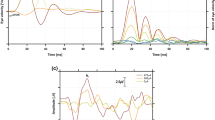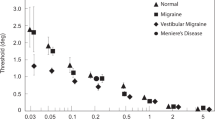Abstract
Meniere’s disease is characterized by sporadic episodes of vertigo, nystagmus, fluctuating sensorineural hearing loss, tinnitus and aural pressure. Since Meniere’s disease can affect different regions of the vestibular labyrinth, we investigated if electrical vestibular stimulation (EVS) which excites the entire vestibular labyrinth may be useful to reveal patchy endorgan pathology. We recorded three-dimensional electrically evoked vestibulo-ocular reflex (eVOR) to transient EVS using bilateral, bipolar 100-ms current steps at intensities of 0.9, 2.5, 5.0, 7.5 and 10.0 mA with dual-search coils in 12 unilateral Meniere’s patients. Their results were compared to 17 normal subjects. Normal eVOR had tonic and phasic spatiotemporal properties best described by the torsional component, which was four times larger than horizontal and vertical components. At EVS onset and offset of 8.9 ms latency, there were phasic eVOR initiation (M = 1,267 °/s2) and cessation (M = −1,675 °/s2) acceleration pulses, whereas during the constant portion of the EVS, there was a maintained tonic eVOR (M = 9.1 °/s) at 10 mA. However in Meniere’s disease, whilst latency of EVS onset and offset was normal at 9.0 ms, phasic eVOR initiation (M = 1,720 °/s2) and cessation (M = −2,523 °/s2) were enlarged at 10 mA. The initiation profile was a bimodal response, whilst the cessation profile frequently did not return to baseline. The tonic eVOR (M = 20.5 °/s) exhibited a ramped enhancement of about twice normal at 10 mA. Tonic eVOR enhancement was present for EVS >0.9 mA and disproportionately enhanced the torsional, vertical and horizontal components. These eVOR abnormalities may be a diagnostic indicator of Meniere’s disease and may explain the vertigo attacks in the presence of declining mechanically evoked vestibular responses.




Similar content being viewed by others
References
Aw ST, Todd MJ, Halmagyi GM (2006) Latency and initiation of the human vestibuloocular reflex to pulsed galvanic stimulation. J Neurophysiol 96:925–930
Aw ST, Todd MJ, Aw GE, Weber KP, Halmagyi GM (2008) Gentamicin vestibulotoxicity impairs human electrically evoked vestibulo-ocular reflex. Neurology 71:1776–1782
Bance M, Mai M, Tomlinson D, Rutka J (1991) The changing direction of nystagmus in acute Meniere’s disease: pathophysiological implications. Laryngoscope 101:197–201
Carey JP, Minor LB, Peng GCY, Della Santina CC, Cremer PD, Halswanter T (2002) Changes in the three-dimensional angular vestibulo-ocular reflex following intratympanic gentamicin for Meniere’s disease. J Assoc Res Otolaryngol 3:430–443
Dinh TAD, Haasler T, Homann G, Jüngling E, Westhofen M, Lückhoff A (2009) Potassium currents induced by hydrostatic pressure modulate membrane potential and transmitter release in vestibular type II hair cells. Eur J Physiol 458:379–387
Della Santina CC, Migliaccio AA, Patel AH (2007) A multichannel semicircular canal neural prosthesis using electrical stimulation to restore 3-d vestibular sensation. IEEE Trans Biomed Eng 54:1016–1030
De Waele C, Meguenni R, Freyss G, Zamith F, Bellalimat N, Vidal PP, Tran Ba Huy P (2002) Intratympanic gentamicin injections for Meniere disease: vestibular hair cell impairment and regeneration. Neurology 59:1442–1444
Fitzpatrick RC, Day BL (2004) Probing the human vestibular system with galvanic stimulation. J Appl Physiol 96:2301–2316
Gibson WP (2010) Hypothetical mechanism for vertigo in Meniere’s disease. Otolaryngol Clin North Am 43(5):1019–1027
Gürkov R, Flatz W, Louza J, Strupp M, Ertl-Wagner B, Krause E (2012) Herniation of the membranous labyrinth into the horizontal semicircular canal is correlated with impaired caloric response in Ménière’s disease. Otol Neurotol 33:1375–1379
Halmagyi GM (2005) Diagnosis and management of vertigo. Clin Med 5:159–165
Jahn K, Naessl A, Schneider E, Strupp M, Brandt T, Dieterich M (2003) Inverse U-shaped curve for age dependency of torsional eye movement responses to galvanic vestibular stimulation. Brain 126:1579–1589
Kitahara M, Takeda T, Yazawa Y, Matsubara H, Kitano H (1984) Pathophysiology of Meniere’s disease and its subvarieties. Acta Otolaryngol Suppl (Stockh) 406:52–55
McNeill C, Freeman SR, McMahon C (2009) Short-term hearing fluctuation in Meniere’s disease. Int J Audiol 48:594–600
Minor LB, Schessel DA, Carey JP (2004) Meniere’s disease. Curr Opin Neurol 17:9–16
Monsell EM, Balkany TA, Gates GA, Goldenberg RA, Meyerhoff WL, House JW (1995) Committee on hearing and equilibrium guidelines for the diagnosis and evaluation of therapy in Meniere’s disease. Otolaryngol Head Neck Surg 113:181–185
Naganawa S, Yamazaki M, Kawai H, Bokura K, Sone M, Nakashima T (2012) Visualization of endolymphatic hydrops in Ménière’s disease after single-dose intravenous gadolinium-based contrast medium: timing of optimal enhancement. Mag Reson Med Sci 11:43–51
Proctor L, Glackin R, Shimizu H, Smith C, Lietman P (1986) Reference values for serial vestibular testing. Ann Otol Rhinol Laryngol 95:83–90
Rauch SD, Merchant SN, Thedinger BA (1989) Meniere’s syndrome and endolymphatic hydrops: double-blind temporal bone study. Ann Otol Rhinol Laryngol 98:873–883
Schuknecht HF (1993) Disorders of unknown or multiple causes. In: Schuknecht HF (ed) Pathology of the ear, 2nd edn. Lea & Febiger, USA, pp 499–529
Sajjadi H, Paparella MM (2008) Meniere’s disease. Lancet 372:406–414
Schuknecht HF (1968) Correlation of pathology with symptoms of Meniere’s disease. Otolaryngol Clin North Am 1:433–438
Taylor RL, Wijewardene AA, Gibson WP, Black DA, Halmagyi GM, Welgampola MS (2011) The vestibular evoked-potential profile of Ménière’s disease. Clin Neurophysiol 122:1256–1263
Weber KP, Aw ST, Todd MJ, McGarvie LA, Curthoys IS, Halmagyi GM (2009) Horizontal head impulse test detects gentamicin vestibulotoxicity. Neurology 72:1417
Wladislavosky-Waserman P, Facer GW, Mokri B, Kurland LT (1984) Meniere’s disease: a 30-year epidemiologic and clinical study in Rochester, Mn, 1951–1980. Laryngoscope 94:1098–1102
Acknowledgments
The authors would like to thank all patients and normal subjects for participating in the study. This research was funded by National Health and Medical Research Council Australia, University of Sydney, Royal Prince Alfred Hospital Neurology Trustees and The Ramaciotti Foundation.
Conflict of interest
The authors declare that they have no conflict of interest. Prof. GM Halmagyi is a consultant for GN Otometrics.
Author information
Authors and Affiliations
Corresponding author
Rights and permissions
About this article
Cite this article
Aw, S.T., Aw, G.E., Todd, M.J. et al. Enhanced Vestibulo-ocular Reflex to Electrical Vestibular Stimulation in Meniere’s Disease. JARO 14, 49–59 (2013). https://doi.org/10.1007/s10162-012-0362-z
Received:
Accepted:
Published:
Issue Date:
DOI: https://doi.org/10.1007/s10162-012-0362-z




